stop start BUICK REGAL 1998 Owners Manual
[x] Cancel search | Manufacturer: BUICK, Model Year: 1998, Model line: REGAL, Model: BUICK REGAL 1998Pages: 388, PDF Size: 20.19 MB
Page 91 of 388
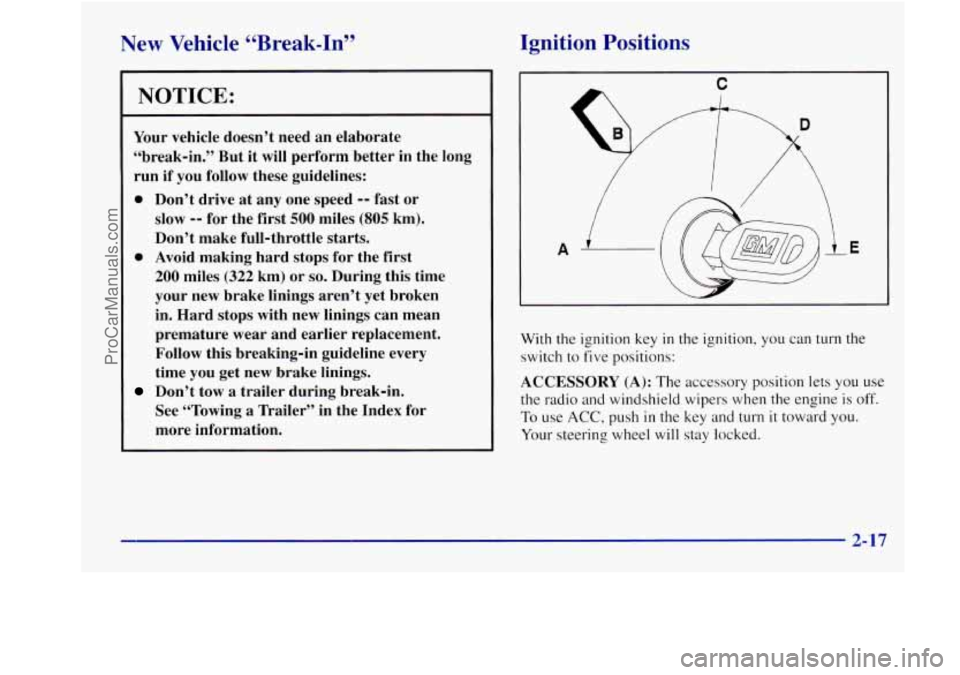
1 sw Vehicle “Break-In” Ignition
Positions
NOTICE:
Your vehicle doesn’t need an elaborate
“break-in.” But it will perform better in the long
run if you follow these guidelines:
0 Don’t drive at any one speed -- fast or
slow -- for the first 500 miles (805 km).
Don’t make full-throttle starts.
200 miles (322 km) or so. During this time
your new brake linings aren’t yet broken
in. Hard stops with new linings can mean
premature wear and earlier replacement.
Follow this breaking-in guideline every
time you get new brake linings.
See “Towing a Trailer” in the Index for
more information.
0 Avoid making hard stops for the first
Don’t tow a trailer during break-in.
A L
With the ignition key in the ignition, you can turn tne
switch to five positions:
ACCESSORY
(A): The accessory position lets you use
the radio and windshield wipers when the engine
is off.
To use ACC, push in the key and turn it toward you.
Your steering wheel will stay locked.
2-17
ProCarManuals.com
Page 93 of 388
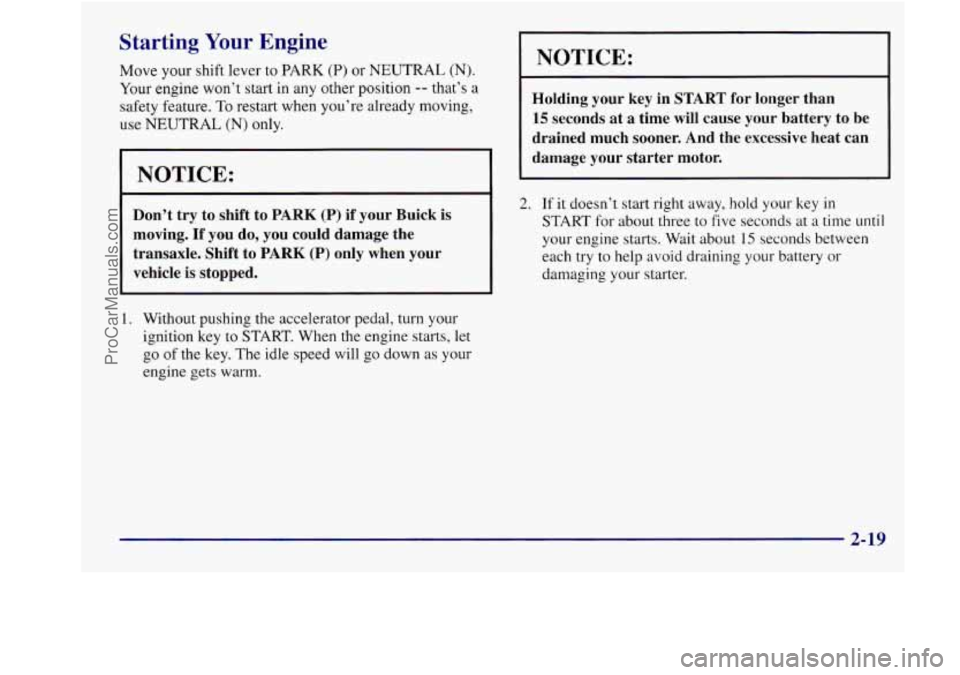
Starting Your Engine
Move your shift lever to PARK (P) or NEUTRAL (N).
Your engine won’t start in any other position -- that’s a
safety feature.
To restart when you’re already moving,
use
NEUTRAL (N) only.
I NOTICE:
~
Don’t try to shift to PARK (P) if your Buick is
moving.
If you do, you could damage the
transaxle. Shift to
PARK (P) only when your
vehicle is stopped.
~ ~
1. Without pushing the accelerator pedal, turn your
ignition key to START. When the engine starts, let
go of the key. The idle speed will go down as your
engine gets warm.
I NOTICE:
Holding your key in START for longer than
15 seconds at a time will cause your battery to be
drained much sooner. And the excessive heat can
damage your starter motor.
2. If it doesn’t start right away, hold your key in
START for about three to five seconds at a time
until
your engine starts. Wait about 15 seconds between
each try to help avoid draining your battery or
damaging your starter.
2-19
ProCarManuals.com
Page 94 of 388
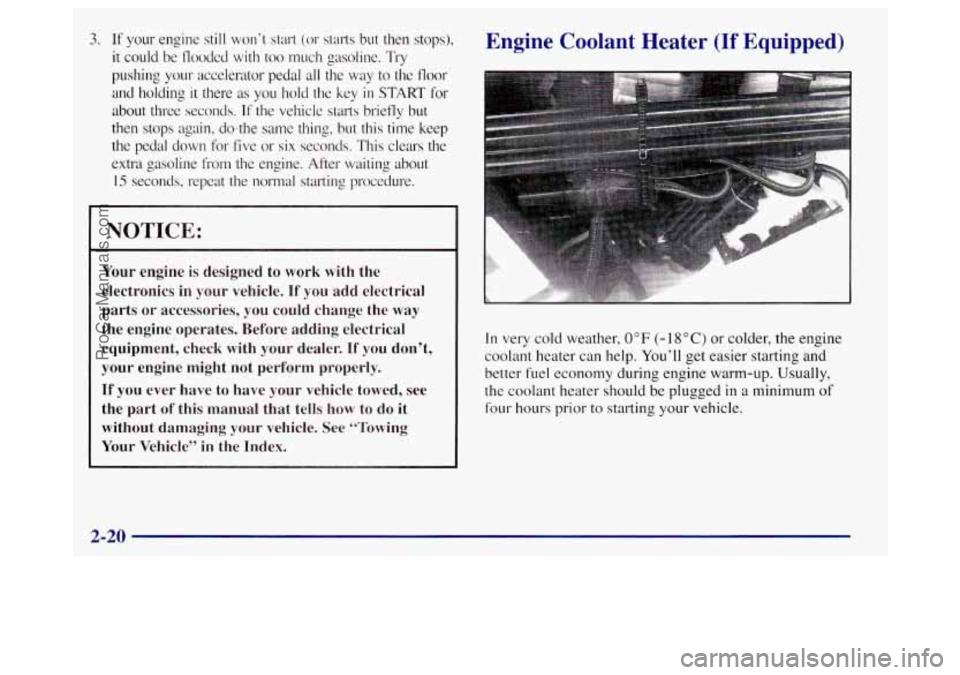
3. If your engine still won’t start (,or starts but then stops),
it could
be flooded with too much gasoline. Tly
pushing your accelerator pedal all the way to the floor
and holding it there
as you hold the key in START for
about three seconds. If the vehicle
starts brkfly but
then stops again, do,the same thing, but this time keep
the pedal down for
five or six seconds. This clears the
extra gasoline from the engine. After waiting about
15 seconds, repeat the noma1 starting procedure.
NOTICE:
Your engine is designed to work with the
electronics in your vehicle.
If you add electrical
parts or accessories, you could change the way
the engine operates. Before adding electrical
equipment, check with your dealer.
If you don’t,
your engine might not perform properly.
If you ever have to have your vehicle towed, see
the part
of this manual that tells how to do it
without damaging your vehicle. See “Towing
Your Vehicle” in the Index.
Engine Coolant Heater (If Equipped)
In very cold weather, 0°F (- 18” C) or colder, the engine
coolant heater can help. You’ll get easier starting and
better fuel economy during engine warm-up. Usually,
the coolant heater should be plugged
in a minimum of
four hours prior to starting your vehicle.
2-20
ProCarManuals.com
Page 97 of 388
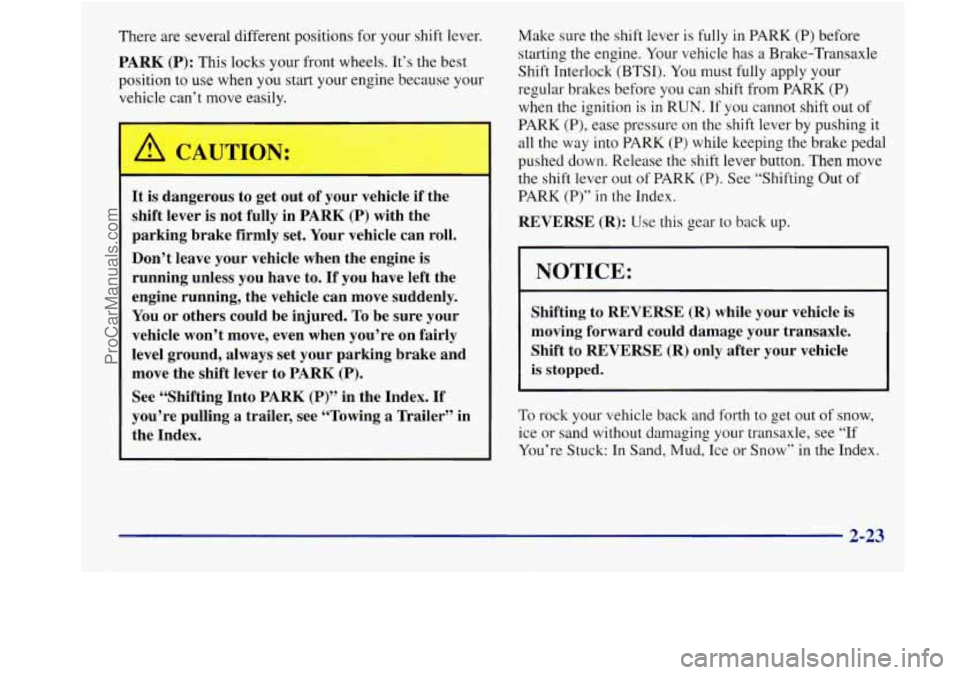
There are several different positions for your shift lever.
PARK
(P): This locks your front wheels. It’s the best
position to use when you start your engine because your
vehicle can’t move easily.
r
It is dangerous to get out of your vehicle if the
shift lever is not fully in PARK
(P) with the
parking brake firmly set. Your vehicle can roll.
Don’t leave your vehicle when the engine is
running unless you have to.
If you have left the
engine running, the vehicle can move suddenly.
You or others could be injured.
To be sure your
vehicle won’t move, even when you’re on fairly
level ground, always set your parking brake and
move the shift lever to PARK
(P).
See “Shifting Into PARK (P)” in the Index. If
you’re pulling
a trailer, see “Towing a Trailer” in
the Index. Make sure
the shift lever is
fully in PARK (P) before
starting the engine. Your vehicle has
a Brake-Transaxle
Shift Interlock
(BTSI). You must fully apply your
regular brakes before you can shift from PARK (P)
when the ignition is in RUN. If you cannot shift out
of
PARK (P), ease pressure on the shift lever by pushing it
all the way into PARK (P) while keeping the brake pedal
pushed down. Release the shift lever button. Then move
the shift lever out
of PARK (P). See “Shifting Out of
PARK (P)”
in the Index.
REVERSE (R): Use this gear to back up.
NOTICE:
Shifting to REVERSE (R) while your vehicle is
moving forward could damage your transaxle.
Shift
to REVERSE (R) only after your vehicle
is
stopped.
To rock your vehicle back and forth to get out of snow,
ice or sand without damaging your transaxle, see “If
You’re Stuck: In Sand, Mud, Ice or Snow” in the Index.
2-23
ProCarManuals.com
Page 110 of 388
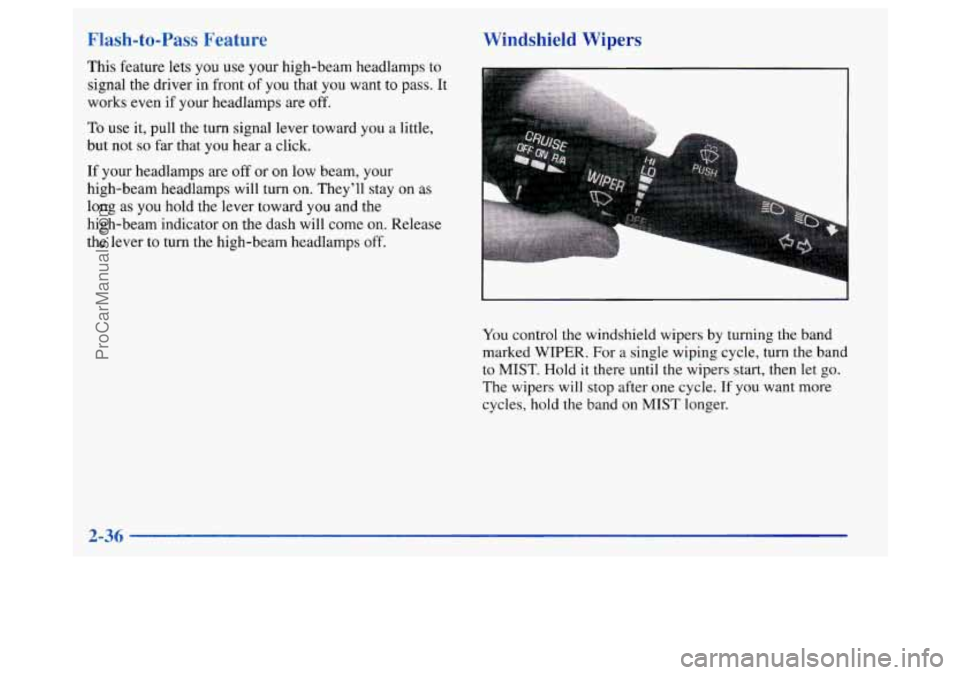
Flash-to-Pass Feature
This feature lets you use your high-beam headlamps to
signal the driver in front of you that you want
to pass. It
works even if your headlamps are off.
To use it, pull the turn signal lever toward you a little,
but not
so far that you hear a click.
If your headlamps are off or
on low beam, your
high-beam headlamps will turn on. They’ll stay on as
long as you hold the lever toward
you and the
high-beam indicator
on the dash will come on. Release
the lever to turn the high-beam headlamps off.
Windshield Wipers
You control the windshield wipers by turning the band
marked
WIPER. For a single wiping cycle, turn the band
to
MIST. Hold it there until the wipers start, then let go.
The wipers will stop after one cycle. If you want more
cycles, hold the band on
MIST longer.
2-36
ProCarManuals.com
Page 124 of 388
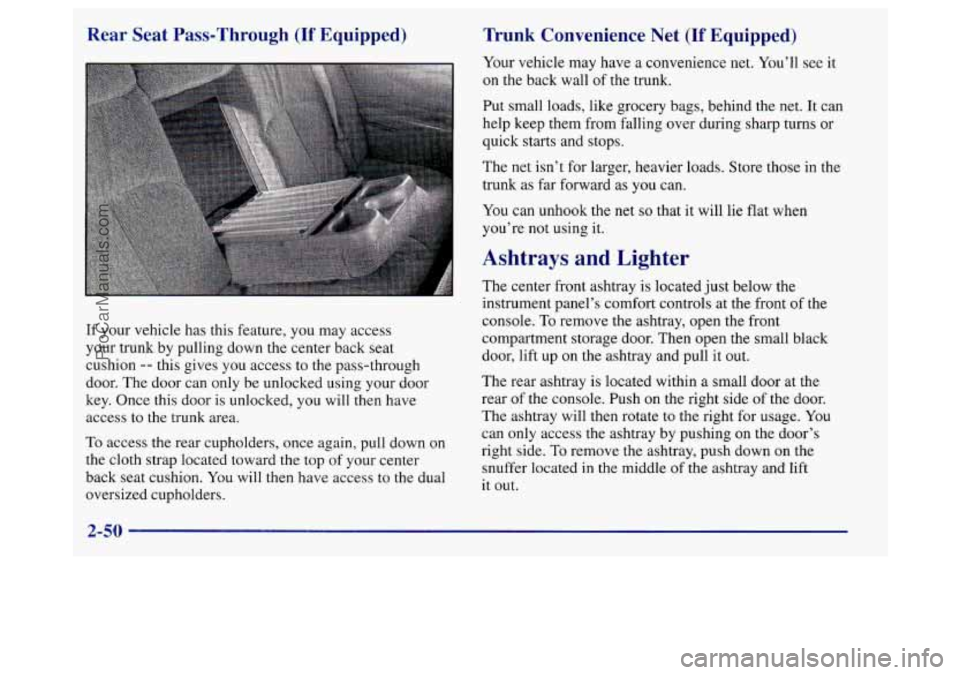
Rear Seat Pass-Through (If Equipped)
If your vehicle has this feature, you may access
your trunk by pulling down the center back seat
cushion
-- this gives you access to the pass-through
door. The door can only be unlocked using your door
key. Once this door is unlocked, you will then have
access to the trunk area.
To access the rear cupholders, once again, pull down on
the cloth strap located toward the top of your center
back seat cushion. You will then have access to the dual
oversized cupholders.
Trunk Convenience Net (If Equipped)
Your vehicle may have a convenience net. You’ll see it
on the back wall of the trunk.
Put small loads, like grocery bags, behind the net. It can
help keep them from falling over during sharp turns or
quick starts and stops.
The net isn’t for larger, heavier loads. Store those in the
trunk as far forward as you can.
You can unhook the
net so that it will lie flat when
you’re
not using it.
Ashtrays and Lighter
The center front ashtray is located just below the
instrument panel’s comfort controls at the front
of the
console.
To remove the ashtray, open the front
compartment storage door. Then open the small black
door, lift up
on the ashtray and pull it out.
The rear ashtray is located within a small door at the
rear
of the console. Push on the right side of the door.
The ashtray will then rotate to the right for usage. You
can only access the ashtray by pushing on the door’s
right side.
To remove the ashtray, push down on the
snuffer located
in the middle of the ashtray and lift
it out.
2-50
ProCarManuals.com
Page 136 of 388

Anti-Lock Brake System Warning Light
ANTI -
LOCK
With the anti-lock brake
system, this light will
come
on when you start your
engine and it will stay
on for three seconds.
That’s normal.
If the light flashes when you’re driving, you don’t have
anti-lock brakes and there could be
a problem with your
regular brakes. Pull
off the road and stop carefully. You
may notice that the pedal is harder
to push. Or, the pedal
may
go closer to the floor. It may take longer to stop.
Have the vehicle towed for service. (See “Towing
Your
Vehicle” in the Index.)
1 CAUI
Your regular brake system may not be working
properly if the anti-lock brake system warning
light is flashing. Driving with the anti-lock
brake system warning light flashing can lead
to an accident. After you’ve pulled off the road
and stopped carefully, have the vehicle towed
for service.
2-62
ProCarManuals.com
Page 137 of 388

If the anti-lock brake system warning light stays on
longer than normal after you’ve started your engine, turn
the ignition off.
Or, if the light comes on and stays on
when you’re driving, stop as
soon as possible and turn
the ignition off. Then start the engine again to reset the
system. If the light still stays
on, or comes on again
while you’re driving, your vehicle needs service.
If the
light is on but not flashing and the regular brake system
warning light isn’t on,
you still have brakes, but you
don’t have anti-lock brakes.
The anti-lock brake system warning light should come
on briefly when you turn the ignition key to RUN. If the
light doesn’t come on then, have it fixed
so it will be
ready to warn you if there
is a problem.
Anti-Lock Brake System Active Light
LOW TRAC
When your anti-lock system
is adjusting brake pressure
to help avoid
a braking skid,
the anti-lock brake system
active light will come on.
Slippery road conditions may exist if this light comes
on,
so adjust your driving accordingly. The light will
stay
on for a few seconds after the system stops
adjusting brake pressure.
The anti-lock brake system active light also comes on
briefly when you turn the ignition key to
RUN. If the
light doesn’t come on then, have it fixed so it will be
there to tell you when the system is active.
2-63
ProCarManuals.com
Page 144 of 388
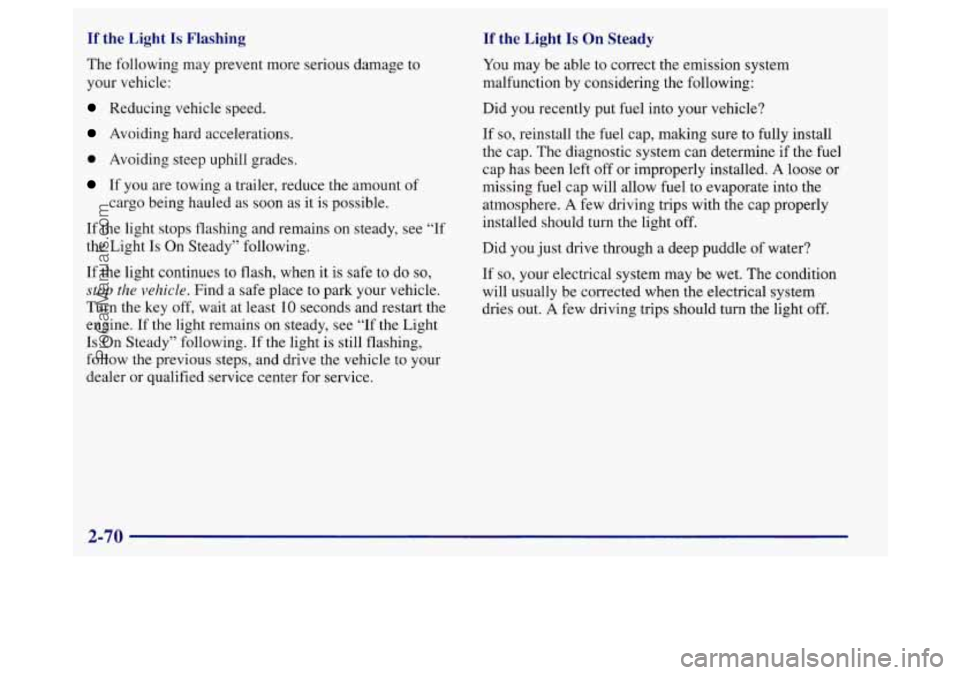
If the Light Is Flashing
The following may prevent more serious damage to
your vehicle:
Reducing vehicle speed.
Avoiding hard accelerations.
0 Avoiding steep uphill grades.
If you are towing a trailer, reduce the amount of
cargo being hauled as
soon as it is possible.
If the light stops flashing and remains on steady, see “If
the Light
Is On Steady” following.
If the light continues to flash, when it is safe to do
so,
stop the vehicle. Find a safe place to park your vehicle.
Turn the key off, wait at least
10 seconds and restart the
engine.
If the light remains on steady, see “If the Light
Is On Steady” following. If the light is still flashing,
follow the previous steps, and drive the vehicle to your
dealer or qualified service center for service.
If the Light Is On Steady
You may be able to correct the emission system
malfunction by considering the following:
Did you recently put fuel into your vehicle?
If
so, reinstall the fuel cap, making sure to fully install
the cap. The diagnostic system can determine if the fuel
cap has been left off or improperly installed.
A loose or
missing fuel cap will allow fuel
to evaporate into the
atmosphere.
A few driving trips with the cap properly
installed should turn the light
off.
Did you just drive through a deep puddle of water?
If so, your electrical system may be wet. The condition
will usually be corrected when the electrical system
dries out.
A few driving trips should turn the light off.
ProCarManuals.com
Page 145 of 388
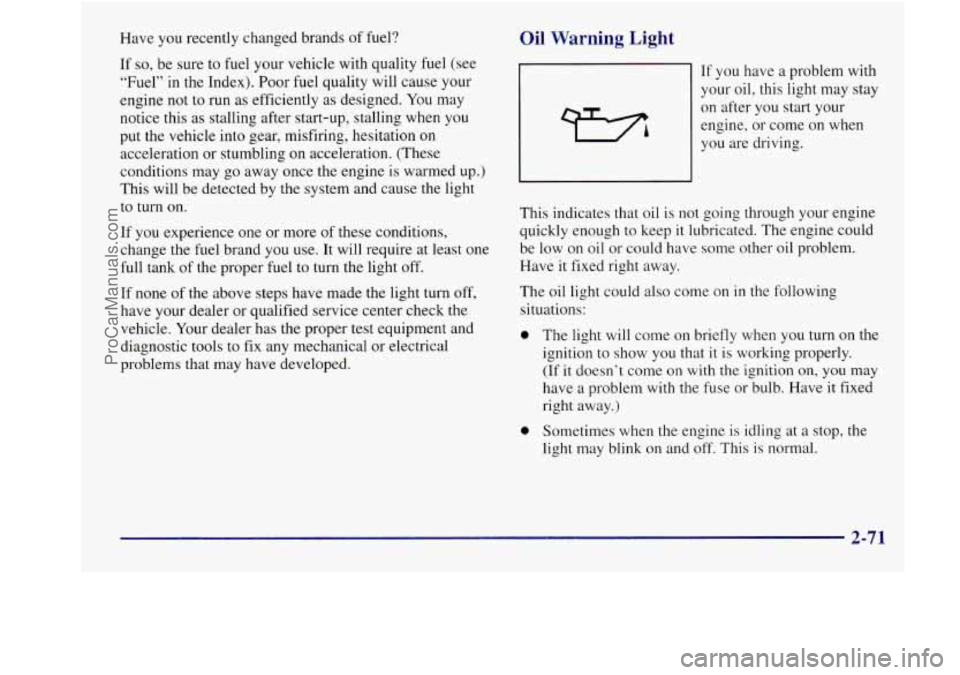
Have you recently cnanged brands of fuel?
If
so, be sure to fuel your vehicle with quality fuel (see
“Fuel” in the Index). Poor fuel quality will cause your
engine not to run as efficiently as designed. You may
notice this as stalling after start-up, stalling when you
put the vehicle into gear, misfiring, hesitation on
acceleration or stumbling on acceleration. (These
conditions may go away once the engine is warmed up.)
This will be detected by the system and cause the light
to turn on.
If you experience one or more of these conditions,
change the fuel brand
you use. It will require at least one
full tank of the proper fuel
to turn the light off.
If none of the above steps have made the light turn off,
have your dealer or qualified service center check the
vehicle. Your dealer has the proper test equipment and
diagnostic tools to fix any mechanical
or electrical
problems that may have developed.
Qil Warning Light
If you have a problem with
your oil, this light may stay
on after you start your
engine, or come on when
you are driving.
This indicates that oil is not going through your engine
quickly enough to keep it lubricated. The engine could
be low on oil or could have some other oil problem.
Have it fixed right away.
The oil light could also come on
in the following
situations:
0
0 The light will come on briefly when you turn on the
ignition to show you that it is working properly.
(If it doesn’t come on with the ignition on,
you may
have a problem with the fuse or bulb. Have it fixed
right away.)
Sometimes when the engine is idling at a stop, the
light may blink on and off. This
is normal.
2-71
ProCarManuals.com